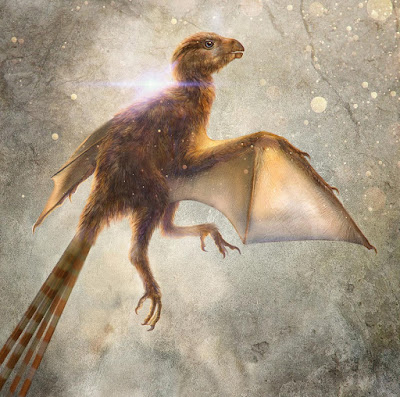 |
| Ambopteryx longibrachium
Wang, O’Connor, Xu & Zhou, 2019
Illustration: Chung-Tat Cheung
|
Abstract
Powered flight evolved independently in vertebrates in the pterosaurs, birds and bats, each of which has a different configuration of the bony elements and epidermal structures that form the wings. Whereas the early fossil records of pterosaurs and bats are sparse, mounting evidence (primarily from China) of feathered non-avian dinosaurs and stemward avians that derive primarily from the Middle–Upper Jurassic and Lower Cretaceous periods has enabled the slow piecing together of the origins of avian flight. These fossils demonstrate that, close to the origin of flight, dinosaurs closely related to birds were experimenting with a diversity of wing structures. One of the most surprising of these is that of the scansoriopterygid (Theropoda, Maniraptora) Yi qi, which has membranous wings—a flight apparatus that was previously unknown among theropods but that is used by both the pterosaur and bat lineages. This observation was not universally accepted. Here we describe a newly identified scansoriopterygid—which we name Ambopteryx longibrachium, gen. et sp. nov.—from the Upper Jurassic period. This specimen provides support for the widespread existence of membranous wings and the styliform element in the Scansoriopterygidae, as well as evidence for the diet of this enigmatic theropod clade. Our analyses show that marked changes in wing architecture evolved near the split between the Scansoriopterygidae and the avian lineage, as the two clades travelled along very different paths to becoming volant. The membranous wings supported by elongate forelimbs that are present in scansoriopterygids probably represent a short-lived experimentation with volant behaviour, and feathered wings were ultimately favoured during the later evolution of Paraves.


 |
| Holotype of Ambopteryx longibrachium, IVPP V24192. |
Theropoda Marsh, 1881
Maniraptora Gauthier, 1986
Scansoriopterygidae Czerkas and Yuan, 2002
Ambopteryx longibrachium gen. et sp. nov.
Etymology. ‘Ambo’, both (Latin); ‘pteryx’, wing (Latin), referring to the
pterosaur-like wing that is present in this non-avian dinosaur; ‘longibrachium’ refers to the elongate forelimb (brachium, upper arm (Latin)).
Min Wang, Jingmai K. O’Connor, Xing Xu and Zhonghe Zhou. 2019. A New Jurassic Scansoriopterygid and the Loss of Membranous Wings in Theropod Dinosaurs. Nature. 569; 256–259. DOI: 10.1038/s41586-019-1137-z
Newly Discovered Bat-Like Dinosaur Reveals the Intricacies of Prehistoric Flight po.st/FwnL8Q via @SmithsonianMag
New species of bat-wing dinosaur discovered on.natgeo.com/2VQ07Dq via @NatGeoScience
The cover image shows an artist’s impression of the newly identified dinosaur Ambopteryx longibrachium. Described in this issue by Min Wang and his colleagues, the fossilized remains of Ambopteryx date to the Upper Jurassic period some 163 million years ago. Ambopteryx is a scansoriopterygid, a group of dinosaurs that are generally reconstructed as small, feathered arboreal climbers, with very long hands and fingers. But Ambopteryx is different — it is the second scansoriopterygid to be found with evidence for both feathers and bat-like membranous wings supported by an accessory bone called the styliform element. The first such specimen, Yi qi, was identified in 2015 and sparked a degree of controversy for its membranous wings. The discovery of Ambopteryx shows that Yi was not alone and raises the possibility that scansoriopterygids in general may have had bat-like wings in addition to feathers. show less
Cover image: Chung-Tat Cheung.
nature.com/nature/volumes/569/issues/7755







